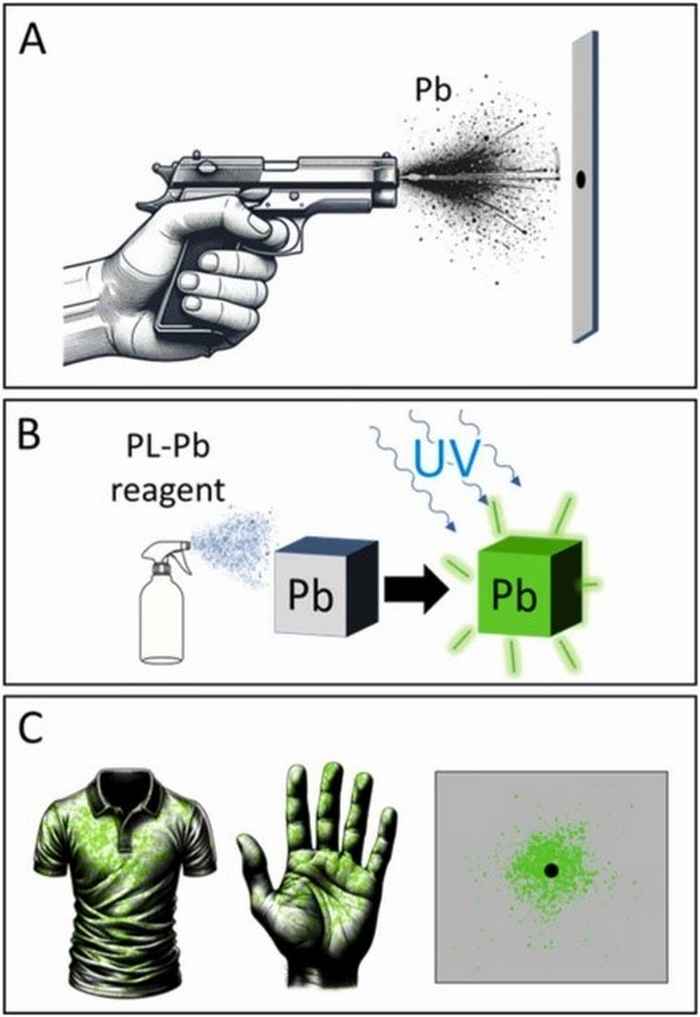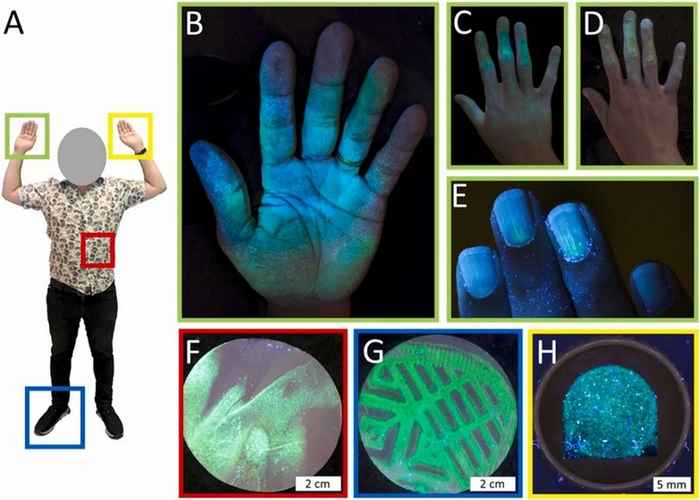Solving crimes with glowing evidence: a brand-new method to detect gunshot residue at the crime scene
15 April 2025
The innovative light-emitting lead analysis method offers exciting opportunities for crime scene investigations. When a weapon is fired, it leaves gunshot residue containing traces of lead in the surrounding environment, including clothing and skin.
hopefully this will allow us to use the light-emitting method soon in actual court cases as evidence
Bente van Kralingen, a forensic expert at the Amsterdam Police, explains: 'Obtaining an indication of gunshot residue at the crime scene is a major advantage, helping us answer key questions about shooting incidents. For instance, determining whether the damage found could have been caused by a bullet and determining the relative position of a person who might have been involved in a shooting incident. We test for lead traces on possible bullet holes and a suspect’s or a victim’s clothing or hands.'
Currently, police send all samples to the lab for analysis. However, the methods used there are often time-consuming, labor-intensive, and require expensive equipment. 'We’re excited about the tests we’re conducting, and hopefully this will allow us to use the light-emitting method soon in actual court cases as evidence,' says Van Kralingen.
Semiconductor technology
The new analysis method builds on recent advances in perovskite research. Perovskites are a promising material used in applications ranging from solar cells to LEDs.

A few years ago, the research group of Wim Noorduin at AMOLF developed an easy-to-use lead detection method based on perovskite technology. In this method a reagent converts lead containing surfaces into a perovskite semiconductor. Shining with a UV lamp will make the newly formed semiconductor emit a bright green glow visible to the naked eye—making even small traces of lead easily detectable.
In 2021, Wim Noorduin and Lukas Helmbrecht (a former PhD student in Noorduin's group) established a start-up company to develop this lead testing method into a practical lead detection kit: Lumetallix. Over the past years, many people worldwide have been investigating their surroundings using the Lumetallix test kit. They report positive tests in all sorts of objects, for example: dinner plates, beer glasses, but also in paint dust at construction sites.
Helmbrecht developed an altered version of the Lumetallix reagent for the forensic application: one that reacts especially well with lead atoms in gunshot residue and produces a long-lasting green glow.
At the shooting range
To validate the effectiveness of this method, the researchers conducted a series of controlled experiments. PhD students Kendra Adelberg and Arno van der Weijden (AMOLF/UvA) visited a shooting range in Amsterdam. Adelberg: 'We used standard 9 mm full metal jacket bullets and fired them from two different pistols at cotton cloth targets placed at various distances. After applying the reagent, we visualized the gunshot residue patterns. The results revealed well-defined luminescent patterns that were clearly visible to the naked eye, even at extended distances,' says Adelberg.
During their experiments, Adelberg and her colleagues made two other remarkable discoveries. Firstly, unlike other methods, the new light-emitting technique remains effective even after extensive washing of the shooter’s hands. This is important for forensic investigations, as suspects often try to tamper with or remove evidence of their involvement. Secondly, bystanders standing approximately two meters away from the shooter also tested positive for lead traces on their hands. 'These findings provide valuable pieces of the puzzle when reconstructing a shooting incident. But, a positive test also needs to be carefully interpreted, it does not automatically mean that you fired a gun,' says Adelberg.

Who will benefit?
The researchers believe this new method will be especially beneficial to first responders, such as police officers, who can use it to rapidly screen potential suspects and witnesses to secure crucial evidence.
Beyond forensic applications, the team is also exploring the potential of this light-emitting method to detect lead contamination in environmental samples such as water and soil. Since lead is toxic and harmful to the environment, this research could have broader implications for environmental monitoring and public health.
Paper details
Kendra Adelberg, Arno van der Weijden, Lukas Helmbrecht, Diede Blaauw, Arian C. van Asten, Willem L. Noorduin: Perovskite-based photoluminescent detection of lead particles in gunshot residue. Forensic Science International, 370, 112415, March 9th (2025).
DOI: 10.1016/j.forsciint.2025.112415
The paper is a joint effort of the groups of Wim Noorduin (heading the Self-Organising Matter group at AMOLF and professor of Self-Organising Matter at the Van 't Hoff Institute for Molecular Sciences at UvA) and Arian van Asten (professor of Forensic Analytical Chemistry and On-scene Chemical Analysis at the Van 't Hoff Institute for Molecular Sciences at UvA).